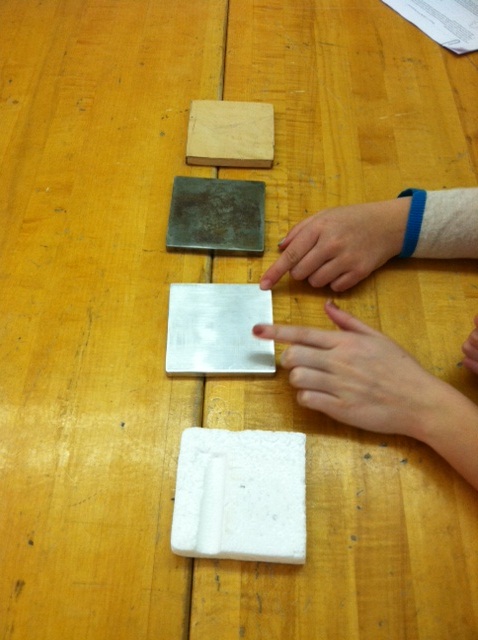You are here: start » days » spring2012daybyday » spring2012day5 » exploring_thermal_phenomena_with_plates
Exploring Thermal Phenomena with Plates
We gave each table four same-size blocks of different materials (2 kinds of metal, wood, and Styrofoam)and a set of diagnostic questions. The questions included:
- Consider (without touching) four plates. Rank these in order of temperature and explain the reasoning for your predicted ranking.
- Touch the four plates. Rank these in order of temperature. Explain the reasoning for your ranking.

Most students were surprised to see that all of the plates seemed to be at the same temperature. Many even said things like, “Are everyone else's thermometer's broken, too?” and “I think this thermometer just isn't sensitive enough to measure the temperature of the plates.”
Through discussion, groups came to a realization that all of the plates are at room temperature and that different materials conduct heat energy more easily or less easily. For example, metal felt colder to the touch because it conducts heat energy more easily than say, wood or Styrofoam.
Emily asked the students to develop powerful ideas as groups to describe the phenomena that they had just observed:
Group 1- The thermal energy from fingers is transferred to metal, increasing its temperature and decreasing ours.
Group 2- Heat transfers from hands to metal (throughout) and to Styrofoam to surface.
Group 3- We are a heat source, the better the conductivity of the material, the more heat “it pulls” (think of this as transferring energy) from the source the colder it is to touch.
Group 4- When we touch a more dense object the heat is leaving our hand at a quicker rate than a less dense material.
Emily noted that it is very tempting to think that more dense materials transfer heat energy more quickly but this turns out not to be the case. If you plot thermal conductivity versus density for many materials listed in tables of material properties, there is no discernable relationship.